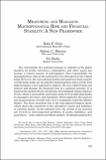Artículo
Measuring and managing macrofinancial risk and financial stability: a new framework
Fecha
2010Resumen
The vulnerability of a national economy to volatility in the global markets for credit, currencies, commodities, and other assets has become a central concern of policymakers. The responsibility for managing these risks at the national level is often given to the central bank. However, the conventional models and analytical tools used by central banks today are ill suited for analyzing these types of risk. This paper proposes a new approach to improve the way central banks can analyze and manage the financial risks of a national economy. It is based on the modern theory and practice of Contingent Claims Analysis (CCA), which is successfully used today at the level of individual banks by managers, investors, and regulators. When applied to the analysis and measurement of credit risk, CCA is commonly called the Merton Model. The basic analytical tool is the risk-adjusted balance sheet, which shows the sensitivity of the enterprise’s assets and liabilities to external shocks. At the national level, the sectors of an economy are viewed as interconnected portfolios of assets, liabilities, and guarantees—some explicit and others implicit.
Colecciones
Descargar


